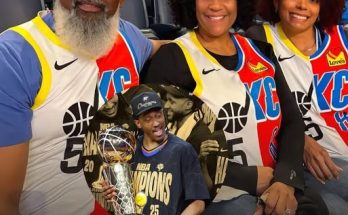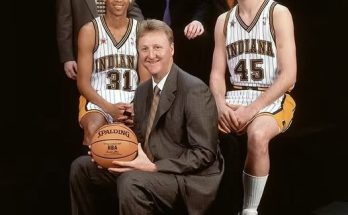In the high-stakes world of college basketball recruiting, momentum can shift in an instant. One moment, you’re the favorite with all the buzz. The next, you’re on the outside looking in as a prized recruit slips away. For Duke head coach Jon Scheyer, that bitter feeling became all too real this week. Despite months of effort, relationship-building, and carefully calculated visits, the Blue Devils fell short in the race for one of the nation’s top prospects—a blow that not only stings in the moment but could have long-lasting implications for the program’s recruiting trajectory.
The elite recruit in question had everything Duke covets: skill, polish, star potential, and a winning mentality. A player many believed would continue the program’s rich tradition of elite talent flowing through Durham. His fit seemed natural, his interest reportedly mutual, and yet, when the final decision came down, he took his talents elsewhere. The moment marked a clear miss in a battle that many insiders felt was Duke’s to lose. It wasn’t just about landing a highly-ranked player—it was about asserting dominance in a fiercely competitive landscape where every commitment carries weight.
Jon Scheyer, now entering his third full season as head coach, has managed to put together strong recruiting classes thus far. He’s landed big names and kept Duke in the national spotlight. However, this miss cuts deeper than most. Not only was the recruit expected to be a cornerstone for the program, but the optics of losing him—especially to a rival blue blood or fast-rising contender—underscore the pressure that comes with following in the footsteps of a legend like Mike Krzyzewski. The question now is whether this is merely a speed bump or a warning sign that Duke’s grip on elite recruiting might be loosening.
What makes this recruiting loss more painful for the Duke faithful is the context. Duke was seen as the early leader. Scheyer and his staff prioritized the recruit from the start, hosting him for multiple visits, showing up at key games, and investing deeply in the relationship. Scheyer, known for his personable approach and basketball IQ, made it clear the player was a priority. The staff sold him on the opportunity to wear a Duke jersey, to play on national TV every week, and to potentially become the next in a long line of first-round NBA Draft picks. On paper, the pitch was compelling.
But recruiting isn’t won on paper. It’s won in living rooms, gyms, and conversations behind the scenes. Somewhere along the line, something shifted. Whether it was NIL opportunities, playing time assurances, or simply a gut feeling from the recruit and his family, another program found a way to close the deal. It’s a reminder that even a program with Duke’s pedigree can’t rest on its laurels in today’s climate. The game has changed. The variables have multiplied.
The significance of this recruiting battle cannot be overstated. The player wasn’t just any five-star prospect—he was a potential game-changer. The type of talent who can tilt the balance of a season, elevate everyone around him, and serve as a magnet for other elite players. Losing him means recalibrating not only the roster projections but also the long-term vision Scheyer had for this particular class. It forces Duke to pivot, to chase Plan B options that may not offer the same upside, and to face questions about its staying power at the top of the recruiting food chain.
This isn’t to say Duke is in trouble. Far from it. The program remains one of the most recognizable brands in college basketball, with a passionate fanbase, a world-class academic institution, and a proven track record of success. But perception matters in recruiting, and high-profile misses—especially when they come in succession—can create a narrative. Whether fair or not, that narrative can influence future decisions. It can give other programs ammunition in the living room. It can chip away at the aura that has made Duke such a formidable force.
For Scheyer, the pressure is real. He’s already shown flashes of brilliance as a recruiter and a coach. He helped bring in players like Cooper Flagg and secured commitments from top-tier talents early in his tenure. But expectations at Duke aren’t just about being good—they’re about being great, about competing for Final Fours and championships year after year. Every roster decision, every recruiting win or loss, is magnified. And in today’s NIL-driven world, recruiting has become more complex than ever. Coaches must now navigate a maze of expectations, financial incentives, brand building, and strategic fit.
The latest recruiting miss also raises broader questions about Duke’s approach. Are they adapting quickly enough to the evolving NIL landscape? Are they striking the right balance between tradition and innovation? Are they still the gold standard for elite prospects looking to take the next step? For decades, Duke was the dream school for countless top recruits. The court at Cameron Indoor, the brotherhood, the banners—it all sold itself. But in 2025, with so many competing forces at play, even the most iconic programs must continue to evolve.
It’s worth noting that recruiting losses happen to every coach and every program. Even the best in the business miss from time to time. What defines them is how they respond. Does Scheyer double down on his efforts, learn from what went wrong, and land another top-tier prospect to fill the void? Or does this miss become part of a larger trend that begins to define his tenure? Those are the questions swirling in the minds of Duke fans and college basketball analysts alike.
The player, now committed elsewhere, will go on to shape another program’s destiny. He’ll be the face on the posters, the name on the marquee, the future NBA lottery pick whose journey took a different turn. And for Duke, the focus now shifts to regrouping, reloading, and finding answers. There’s no time to dwell—not with the transfer portal buzzing, the AAU circuit heating up, and the next wave of talent already on the horizon. Recruiting never stops. The next big battle is already underway.
Still, this one will linger. It will be remembered not only for who Duke lost but for what it represents—a missed opportunity, a reminder of how fragile recruiting momentum can be, and a challenge to a young coach who’s still carving out his identity on one of the sport’s biggest stages. Jon Scheyer isn’t new to pressure. He lived it as a player and has embraced it as a coach. But now more than ever, he must prove that Duke can still win the biggest battles, not just compete in them.
Because in college basketball, the difference between good and great often comes down to moments like this—when a top recruit chooses to go somewhere else, and a program is left wondering what more it could have done.



